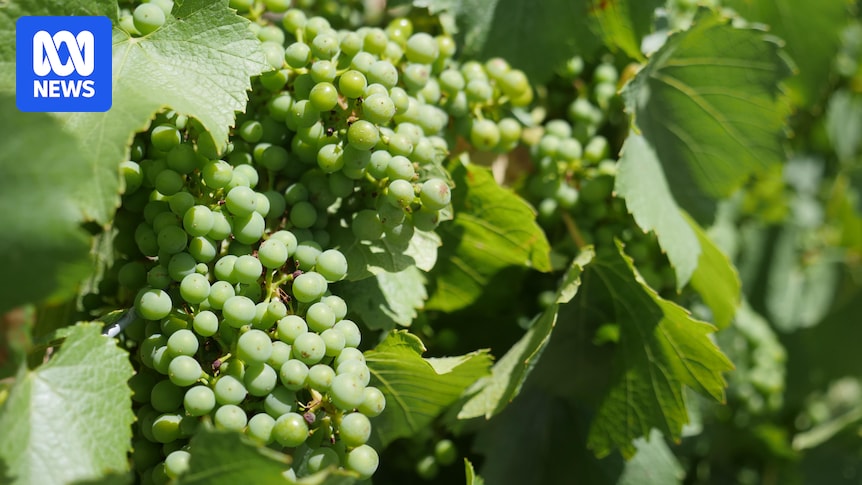There are fears farmers in Australia’s largest wine grape growing region will be forced to walk off the block as white wine grape prices are expected to drop due to an oversupply this upcoming vintage season.
The wine industry across Australia has been battling a global oversupply of red wine grapes due to international market changes and shifting consumer behaviour for the past five years.
In South Australia’s Riverland, early price indicators for the 2026 vintage show shiraz prices as low as $80 to $120 per tonne.
That is according to Riverland Wine, which also said the cost of producing grapes exceeded $350 per tonne.
While low prices were expected, the industry is preparing for white grape prices to also plummet.
It is a blow for growers like Amanda Dimas who has had grapes growing on her family block for three generations.
Amanda Dimas said growers are running out of places to turn to pull them through the tough market conditions. (ABC Riverland: Shannon Pearce)
“We don’t have any more capital left to diversify, change plantings, and even if we [could], whites have taken a turn for the worst,” she said.
“We’ve removed all of our shiraz and planted chardonnay, so it’s just another kick in the guts.
“You’ve spent that hard-earned money to reinvest and it’s not got us anywhere.”
Brigid Nolan said prices for chardonnay and sauvignon blanc are the white varieties under the most pressure. (ABC News: James Wakelin)
The Wine Group, based in Loxton and which processes grapes, said white varieties including chardonnay and sauvignon blanc had been touted as a transition option for growers who were trying to survive the decline of reds in recent years.
That had now backfired.
“Due to the downturn in the reds we’ve found some growers have planted whites and we’re finding that they’re now coming into that oversupply situation as well,” general manager Brigid Nolan said.
“Unfortunately, unlike some of the other agricultural industries in Australia, it doesn’t seem to be as cyclical.
“It comes to a point where it’s just not economically viable and we are going to start seeing the devastation of that with some pretty sad looking vines and vineyards.”Industry in crisis
Riverland Wine has penned an “urgent letter” to Premier Peter Malinauskas describing the region as being “in the grip of a severe economic and social crisis”.
It has called for a government-led crisis meeting with industry, peak bodies and grower representatives before the end of January.
“While this may sound like a familiar call for help, please understand that the risk of your inaction is now catastrophic,” the letter read.
“Right now, the Riverland is breaking.”
Riverland Wine is pleading for the state government to step in and help growers exit the industry. (ABC Riverland: Will Hunter)
Board member Peter Hill said South Australia’s identity as a wine state will be at risk if action is not taken by government in some form.
“The outlook is catastrophic … not just for the industry, it’s for this whole community, the whole state,” he said.
“You don’t have to go too far and you can talk to people in the Barossa or Clare or McLaren Vale, Langhorne Creek — they’re all in trouble.
“The wine industry is a big industry in this state and you would think it would attract the premier for help.”
The state government said Riverland Wine’s request had been received and is under consideration.
It acknowledged the current industry conditions and said the Department of Primary Industries had established multiple programs totalling $15 million in investment.
The programs include a $2.5 million South Australian Wine Recovery Program to support vineyard waste management of abandoned or removed vineyards and a national vineyard register to inform supply and demand decisions.
Last week the state government also announced a third round of rebates to encourage growers to “rest” their vines this season.
Wine grape growers could lose up to $270 per tonne on red wine grapes this vintage. (ABC Riverland: Shannon Pearce)
Diversification might be too late
Diversifying crops had been suggested within the industry as a way of mitigating growers’ reliance on wine grapes.
Ashley Ratcliff, owner of Ricca Terra Wines in Barmera, has been expanding his crops to include olives and agave.
He said while it was an option, it had risks of causing oversupply in other industries too.
“You put in too many things like olives or almonds or pistachios and also flood the market,” he said.
Mr Hill said it is also not simple to transition crops.
“Whatever you do costs a lot of money to replant,” he said.
“Growers’ financial resources are now exhausted because it’s been three years of below cost of production pricing.
“Without any help, the next step will be growers walking off properties.”


Dining and Cooking